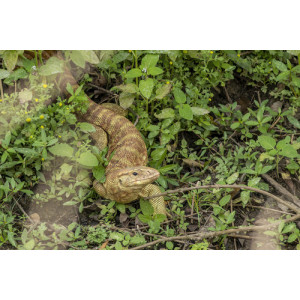Bengal Monitor Did you see this animal?
Scientific Name : Varanus bengalensis
Family : Varanidae
Order : Squamata
Class : Reptilia
Phylum : Chordata
Habitat : Backyards of human dwellings,Cropfields,Forests
Description : The Bengal monitor is one of the largest monitor lizards, growing up to 6 feet (1.8 meters) in length. It has a stout body with strong legs, a long tail, and a large head with a long, forked tongue. It is typically gray or brown in color, with black spots or bands on its back and tail.
These lizards are carnivorous and feed on a variety of prey, including insects, small mammals, birds, reptiles, and eggs.
Bengal monitors are found in a variety of habitats, including forests, grasslands, and agricultural areas. They are often found near water sources, such as rivers or ponds.
Bengal monitors are primarily active during the day and are often seen basking in the sun. They are good climbers and swimmers, and are also able to run quickly on land. They are known to be aggressive and will defend themselves if threatened.
These lizards reproduce by laying eggs. Females will typically lay 10-30 eggs in a burrow or other sheltered location. The eggs hatch after 2-3 months, and the young lizards are independent at birth.
The Bengal monitor is classified as a species of least concern by the IUCN. However, it is threatened by habitat loss and hunting for its meat, skin, and other body parts, which are used in traditional medicine.
These lizards are carnivorous and feed on a variety of prey, including insects, small mammals, birds, reptiles, and eggs.
Bengal monitors are found in a variety of habitats, including forests, grasslands, and agricultural areas. They are often found near water sources, such as rivers or ponds.
Bengal monitors are primarily active during the day and are often seen basking in the sun. They are good climbers and swimmers, and are also able to run quickly on land. They are known to be aggressive and will defend themselves if threatened.
These lizards reproduce by laying eggs. Females will typically lay 10-30 eggs in a burrow or other sheltered location. The eggs hatch after 2-3 months, and the young lizards are independent at birth.
The Bengal monitor is classified as a species of least concern by the IUCN. However, it is threatened by habitat loss and hunting for its meat, skin, and other body parts, which are used in traditional medicine.
Distribution in Bangladesh
References:
description written by: Razia Sultana Setu,Department of Zoology,University of Dhaka ; information source:Wikipedia, IUCN Red List Bangladesh Volume-4 2015; photo credit: swgarnett (www.inaturalist.org/people/swgarnett), photo copyright: iNaturalist. more information please contact with us.
description written by: Razia Sultana Setu,Department of Zoology,University of Dhaka ; information source:Wikipedia, IUCN Red List Bangladesh Volume-4 2015; photo credit: swgarnett (www.inaturalist.org/people/swgarnett), photo copyright: iNaturalist. more information please contact with us.






























